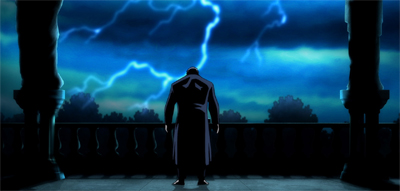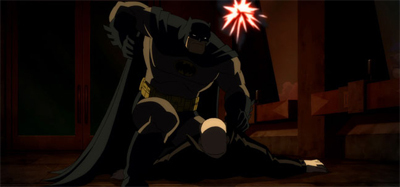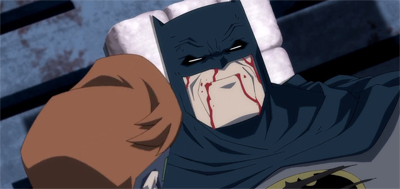Frank Miller’s The Dark Knight Returns might just be the most influential Batman comic ever written. It offers a glimpse an alternate future where Batman has retired as Gotham’s protector, and where a new wave of violence brings him back out of that retirement. It is also, and perhaps more notably, a study of the character’s psychology. It’s notable for suggesting that Bruce Wayne’s obsessions might be ultimately self-destructive and that there’s a primal conflict between the “Batman” part of his persona and Bruce Wayne. Like Watchmen, it’s generally recognised as one of the comics that represented a maturity in the medium.
Warner Brothers have produced an animated adaptation of Frank Miller’s classic, and I can’t help but admire it a great deal. While Alan Moore’s Watchmen was a novel that never really lent itself to film, Miller’s The Dark Knight Returns always had a cinematic quality that I think director Jay Oliva captures remarkably well.
In order to fully capture Miller’s four-part miniseries, the animation team decided to split the story in half. None of these animated films have run more than an hour-and-a-half, and that seems a relatively short runtime for Miller’s impressively vast story. Instead, the movie will be released in two hour-and-twenty-minute instalments. While splitting a story like that can feel a little awkward, it helps that Miller’s four-issue series is relatively episodic. Themes, characters and ideas overlap from one chapter to the next, but each has its own structure, adversary and climax. This first film covers the first two chapters, and the second half will offer an adaptation of the final two.
It does mean that this first half is tasked with doing a lot of heavy-lifting in terms of character work. While the first half of the story pits Bruce against a recovering Harvey Dent and a new gang in Gotham calling themselves the mutants, the second half contains two much more significant confrontations. While there is a certain amount of “pay-off” to be found in this first half, it’s quite clear from watching it that the real climax will come in The Dark Knight Returns, Part II.
The Joker barely appears in this first half, with Michael Emerson only getting to stutter “B-b-batman… darling” before the credits role. Superman is nowhere to be seen. Lacking that sort of name-recognition and the sense of closing out decades of character history, The Dark Knight Returns, Part I is very much a sombre character study of an older Bruce Wayne. Frank Miller’s The Dark Knight Returns heavily inspired Christopher Nolan’s The Dark Knight Rises, so a lot of touches will seem quite familiar to those who checked out the final movie in Nolan’s trilogy.
At the centre of both stories is the idea of Bruce Wayne coming out of retirement to face the next generation of crime. “Don’t call us a gang,” the mutant leader insists, clearly believing that “Gotham City belongs to the mutants.” It’s not too far from Bane’s promise to show Gotham “the next era of Western Civilisation.” The threat to Gotham is monumental, a social erosion, a decay of hope. The Dark Knight Returns, Part Ioffers a version of Gotham that exists without hope.
“Crime is at a record high in Gotham, and nobody seems to be doing a thing about it!” the new tells us. When a pimp tries to beat up a prostitute in the back of his taxi, the driver is only concerned about the finish on the seats. “Take it some place else, I just had the seats cleaned!” A wad of cash shuts him up. As with Nolan’s film, The Dark Knight Returns positions Batman as a symbol who can stand against such apathy. Gordon has quite a few ways to contact the Batman, but he still uses the bat signal. It’s not for Batman or even for him. It’s “so everyone’ll know.”
The film adaptation stumbles a bit in handling this aspect of the source material. The Dark Knight Returns, Part Iis very faithful to the form and concept of Miller’s work, but it seems to shy away from some of the particulars. It lacks the same sort of uncomfortable edge that Miller had. Miller’s work explored how Bruce was a man, but Batman was a black canvass on to which society could project its own fear, prejudices and ideas.
As such, in the novel, it’s shocked when one character praises Batman’s work – only to hope that the hero might target the homosexuals next. It makes us wonder about how people project their own prejudices and their own point of view on to things that aren’t necessarily in synch. The movie adaptation lacks the courage to mock this side character’s homophobia, and so instead makes a joke about Batman going after his landlord. It’s a similar gag, but it lacks the punch of Miller’s original.
Most of the changes are relatively small, but fairly significant in terms of character and tone. Like the novel, the film suggests that Bruce is particularly sympathetic to children who have been harmed or suffered loss. The report that finally pushes Bruce out of his retirement is the story about the gang “kidnapping and murdering young children, a line even the mutants hadn’t crossed until now.” One crucial moment in the novel sees Bruce confronted by a gang member with a gun at a child’s head. In the novel, Bruce fires the weapon to save the kid’s life – a moment of massive philosophical compromise for the Caped Crusader, and a point at which the man divorces himself from the myth. (Nolan’s movies are full of similar moments.)
The film compromises on this moment as well, allowing Bruce to subdue the attacked without firing a gun. It robs the scene of its power. After all, seeing Batman use a gun is an unnerving sight, and an illustration that perhaps Batman isn’t quite the mythological figure that we all thought he was, willing to put saving a kid’s life above his own moral principles. After all, the story makes the point that the “Batmobile” uses projectile weapons – albeit with “rubber bullets.”
(That said, there is one scene that works quite well, expanding on the source material. Confronting a corrupt military general who sold arms to the mutants, the comic was decidedly ambiguous about the character’s death – instead lingering on a splash page of Bruce holding the character draped in the American flag. Here, it’s made explicit that Bruce pushed him to suicide. “Nice way to end your career, general,”he states, presenting the man with a gun and walking away.)
It’s nice to see The Dark Knight Returns get an animated adaptation in the same year as The Dark Knight Rises hit cinemas, because both differ fundamentally in their portrayal of Batman and Bruce. Miller’s take on the character – Bruce is a “hollow shell” that provides a warm body for Batman – has become a massively influential one, and it’s nice that Nolan’s work on The Dark Knight Rises suggests another one. Miller insists that the union of Bruce and Batman cannot end well for either, and has dominated portrayals of the character’s future for over two decades. The Dark Knight Rises dares to offer an alternative, so it’s nice to see both released within the same year.
The Dark Knight Returns suggests that Bruce must eventually be consumed by Batman and swallowed whole, while The Dark Knight Rises suggests that Bruce and Batman could find a way to coexist. Miller’s story uses Harvey Dent’s repeated descent into madness as a commentary on Batman’s own psychological problems. Hearing that Harvey has disappeared, Bruce Wayne issues a short statement to the press, “We must believe we can all defeat our own private demons.”
“I played along as long as I could,” Harvey confesses to Batman, seeming physically and psychologically defeated. He laments, “Who are we kidding? They couldn’t fix me. Nothing can change what I am.” Batman replies, “You and me both.” Discussing Dent with Commissioner Gordon, the closest thing Bruce has to a friend, much like Alfred is the closest thing he has to a father, the comparison is made more explicit:
Maybe. He’s scratching both sides new. As if he’s become consumed by his dark side. I wouldn’t rule cut that he’s hurting himself. It must have been impossible to resist the compulsion.
We still talking about Dent?
On discovering that Harvey’s final villainous plan is actually a suicide mission, Bruce muses, “He wants to die. And take thousands with him.”Is Bruce just as suicidal? Alfred repeatedly points out that Bruce will likely die if he keeps going out there, and Bruce keeps refusing to listen.
The adaptation opts not to include Miller’s internal monologues. The animated adaptation of Batman: Year One made a point to include them, but it also demonstrated how cheesy they could be. Bryan Cranston was perfectly able to handle Miller’s hard-boiled macho monologues, but Ben McKenzie repeatedly struggled with them. Maybe it was a good, safe idea to omit them, as there’s no way of knowing how an actor would deal with them.
To be fair to The Dark Knight Returns, Part I, a lot of the key points are covered in dialogue, and in a way that doesn’t feel especially clunky. And this version of Bruce seems a bit tougher to get a read on than Miller’s, leaving it up to us to try to determine the truth (if any) in what the media says about him. It does mean that we lose out on some classic Miller lines, but I think the movie handles it well enough that it’s a relatively small trade-off. And Peter Weller makes the Miller-ism he delivers suitably unnerving. After one brutal take-down, Bruce assures the arresting officers, “He’s young. He’ll walk again. But he’ll stay scared – won’t you punk?”
The casting is mostly top notch. While it might have been great to see Michael Ironside reprise the role (having played it in an episode of Batman: The Animated Series), Weller does a pretty great job playing an older and more brutal Batman. He’s solid throughout, but there are points when he is exemplary, such as during Batman’s confrontation with the mutant leader. It takes considerable talent to handle Miller’s dialogue, and Weller is up to the task. I’m looking forward to seeing the actor play off against Michael Emerson as the Joker.
The rest of the cast is also very good. The only possible exception is David Shelby as Commissioner Gordon. Shelby portrays a noticeably soft Gordon, rather than one hardened by years in Gotham. Then again, perhaps that’s point. Gordon remains human in a way that Batman couldn’t, so maybe Shelby’s subdued and quiet portrayal suits the character. The talking heads are especially well handled, and I especially like Paget Brewster as a radical right-wing Lana Lang and Michael McKean as pop psychologist. “Merv, I’m absolutely convinced of Harvey’s Dent’s innocence. But that’s not to say he hasn’t returned to crime. I know that sounds confusing to the layman, so let me explain.”
Jay Oliva’s direction is great. The animation shrewdly decides not to try and emulate Miller’s unique artistic sensibilities. This means, of course, we’re robbed of the physical transformation from Adam West’s Batman into Frank Miller’s Batman, but it gives the movie a more consistent feel. The Dark Knight Returns, Part I is probably the best-looking animated movie from Warners Animation, and it looks consistently fantastic. Oliva does a great job managing the media inserts, a part that I can’t imagine was easy to translate from the comics.
The Dark Knight Returns, Part I is a nice adaptation of Frank Miller’s first two chapters of The Dark Knight Returns. It’s too early to judge the entire adaptation, as the second part will really make or break this animated take on Frank Miller’s iconic Batman story. However, given the constraints facing the tea – where a two-hour-and-forty-minute adaptation was impossible – the split is necessary, and handled quite well. We’re off to a pretty great start, and I can’t wait for the release of the second instalment.
Filed under: Non-Review Reviews | Tagged: arts, batman, Bruce, bruce wayne, ChristopherNolan, Dark Knight Return, dark knight returns, Dark Knight Rises, DarkKnight Rises, Dent, frank miller, FrankMiller, gordon, gotham, gotham city, Harvey, joker, Lana Lang, Michael McKean, Paget Brewster, Peter Weller, two face, Warner Bros |






























I just hope Pt. II doesn’t strictly adhere to Miller’s story. I have a lot of qualms with the conclusions.
I’m fairly open-minded when ti comes to Batman, and I quite like the finale. Though Miller did go a bit too far in the sequel and All-Star. What exactly are you referring to? The Sons of Batman? The fight with Superman?